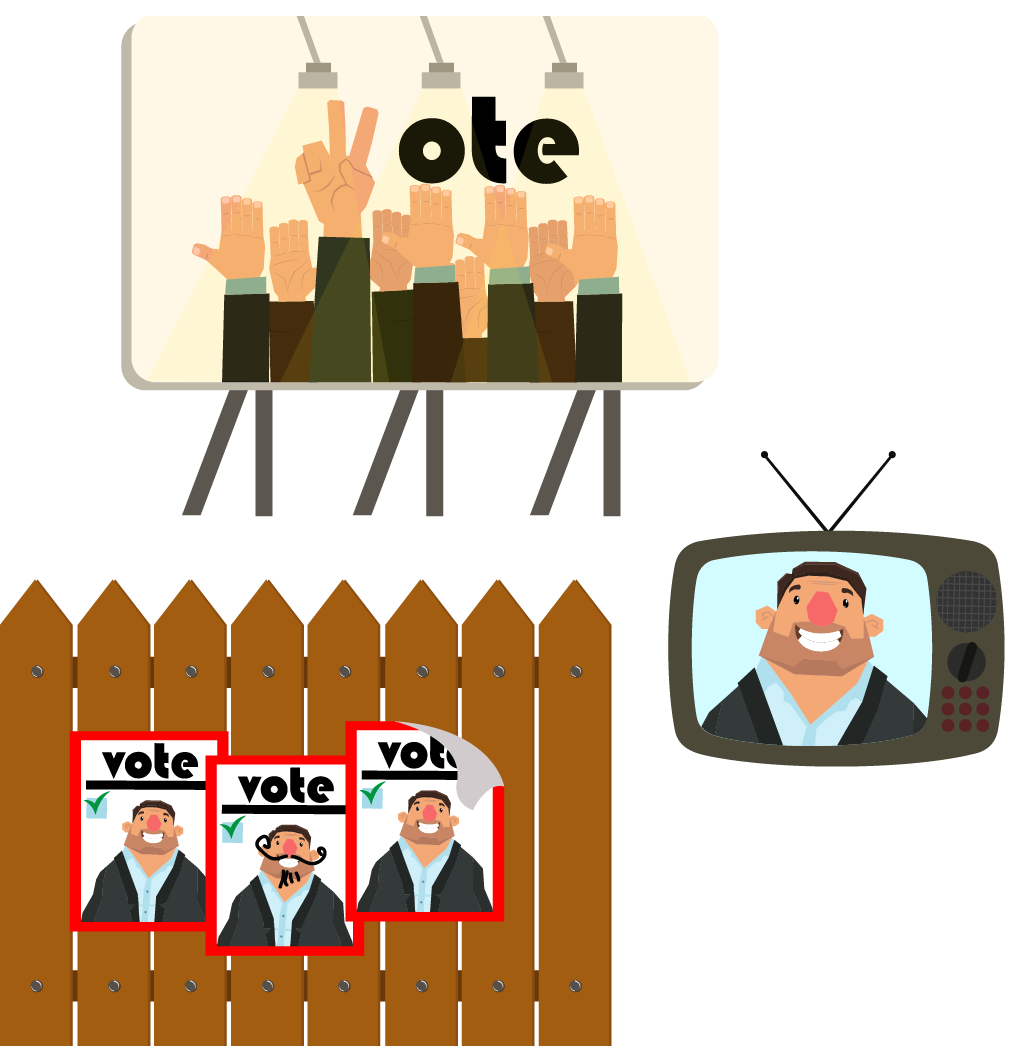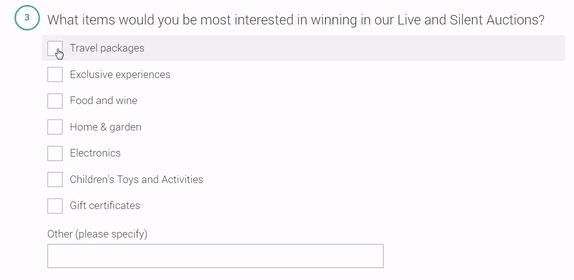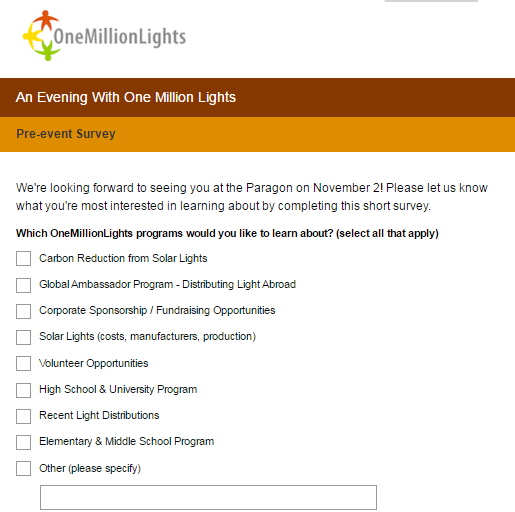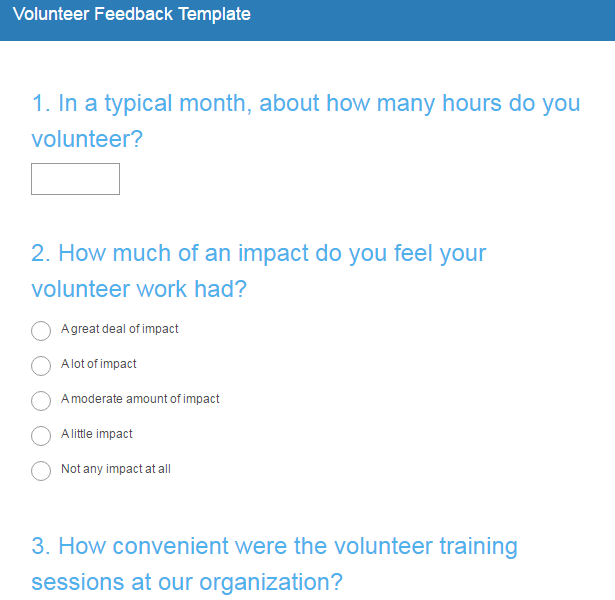How well do you know your donors?
Perhaps you’re pretty familiar with those that support your cause. Your organization is well established. You’ve been hosting fundraising events, meeting with major donors and recruiting board members for decades.
Maybe you’ve just joined, or the organization itself is new. There’s a lot to learn.
Whether you’re a long-time staff member or recent recruit, your donor database is changing (and hopefully growing) every day. If you’re not carefully tracking your donors, you might be surprised at the characteristics of your “average donor”.
The more you know about your audience, the more you can plan programs, giving campaigns and fundraising events with personal impact.
Today we are going to look at one great way to get to know your supporters: conducting online surveys. We’ll cover:
- Choose an Online Survey Tool
- Create Your Survey
- Great Questions for Donor Feedback
- Great Questions for Planning Events
- Great Questions for Post-event Feedback
- Surveys in Action: Help Improve Winspire News!
Want to improve your marketing and social media efforts, improve volunteer opportunities, choose a new theme for the next giving campaign or all of the above? Read on for a beginner’s guide to nonprofit surveying.
Choose an Online Survey Tool
According to the May/June issue of Nonprofit Hub Magazine, one of the most common reasons nonprofits do not survey donors is the time commitment of tracking and interpreting data.
So you might be surprised at the wealth of user-friendly, convenient and affordable online survey tools at your disposal.
While you might have one or two donors that would prefer to fill something out by mail or over the phone, gone are the days of manually entering responses into a spreadsheet. There are hundreds of high-functioning survey tools available that fit any organization size and budget.
Let’s look at 3 of the most popular options.
- Google Forms – My personal favorite of the bunch. Answers are automatically stored in a corresponding Google Sheet, which is the free Google version of Excel that is easily shared (or kept private for your team’s eyes only). You can choose from a variety of themes and templates, add your logo, create unlimited surveys for unlimited respondents, embed the survey directly into your website and more. The feature that sets Google Forms apart: free “skip logic,” or the ability to skip to certain questions based on respondents’ answers.
- SurveyMonkey – SurveyMonkey is still the most popular and free online survey tool. In the free version, you can host 10 questions for 100 respondents, plus get sleek customizations and embedding of the surveys as well. The main downside: You can’t export your data for free. They offer discounted paid versions for nonprofits starting at $17 monthly (35% off).
- Typeform – Typeform excels in pairing typography, fonts, color and graphics for a sleek, elegant and simple final product. You’ll also get unlimited questions, unlimited answers and free data export. One additional nice feature is that you can ask for the respondent’s first name, then use it to populate other fields in the survey for a very personal feel. The only thing missing from Typeform’s free capabilities is skip logic. Typeform offers discounted paid versions for nonprofits starting at 40% off the yearly plan.
Bottom line: Choose the program that feels the most comfortable and intuitive to the person who will actually be working with the data. Take advantage of the free trials survey providers offer, and have your database point person try them out before committing to one.
8 Guidelines to Create Your Survey
Now that you’ve chosen an online survey provider, it’s time to come up with the most relevant questions for your audience. Here are a few best practices of surveying to consider.
1. Make sure the survey is worth your donor’s time.
Winspire surveys show the majority of Winning Bidders attend four or more philanthropic events each year. That’s a whole lot of events on the social calendar! Your donors are busy people. Surveys need to be not just “short”, but meaningful. This leads us to our next point…
2. Commit to changing course based on input.
Author and entrepeneur Seth Godin offers this insight on surveys:
“Here’s a simple test I do, something that has never once led to action: In the last question of a sloppy customer service survey, when they ask, “anything else?” I put my name and phone number and ask them to call me. They haven’t, never once, not in more than fifty brand experiences.
If you’re not going to read the answers and take action, why are you asking?
The best question to ask about a survey: Do we actually have to run this?”
While some 90 percent of nonprofit professionals report collecting data, only 40 percent say they use data to make decisions – and just 5 percent let data impact every decision.
Our take: You don’t need to be a statistician to benefit from data.
Don’t bother taking the time to collect data, but never get around to analyzing or interpreting the results. Resolve to either use the information to improve your organization, or save yourself the trouble altogether.
3. Consider how questions affect donors.
 Whichever candidate you’re backing this election season, you’ve probably heard a lot about “the polls”. One common tactic campaign offices use to sway voters is push polling, a marketing technique in which poll-takers use opinion questions to alter voters’ beliefs (under the guise of third-party objectivity).
Whichever candidate you’re backing this election season, you’ve probably heard a lot about “the polls”. One common tactic campaign offices use to sway voters is push polling, a marketing technique in which poll-takers use opinion questions to alter voters’ beliefs (under the guise of third-party objectivity).
Ask a constituent, “What is the biggest setback you’ve noticed under Senator Jones’ administration?”, and they’re more likely to feel negatively about Senator Jones.
Ask a donor, “If you knew our organization’s budget has a $50,000 deficit going into year-end giving, would you give more or less?” and you just might turn them off from the survey and giving entirely.
While it’s tempting to adopt push polling methods, you’re much better off collecting honest feedback and constructive criticism.
{{cta(‘e6b774cd-8474-4d95-a967-a82f53d5c0cb’,’justifycenter’)}}
4. Keep questions simple and to-the-point.
Make the questions you need to know required; make the questions that would be nice to know optional. That goes for contact information too – make the survey anonymous by default, but give the opportunity to leave their name and email if they desire.
We mentioned your donors are busy people. Keep the survey brief, under 10 minutes. This means not only limiting the number of questions but also how many open-ended questions or comment boxes you include. Multiple choice options, checkboxes, choosing from a linear scale of 1 to 10 and the like are safer bets than open-ended text – and a lot easier for your database manager to sort through later.
5. Incentivize the survey.
To boost participation, including a small incentive (like raffling off a $50 Amazon gift card) never fails to get a wide range of responses.
 6. Look for correlations.
6. Look for correlations.
Finding patterns and connections is key to getting the most out of your data.
Let’s say you ask about donors’ favorite method of receiving communications. While a convincing 75% may prefer weekly emails, that doesn’t mean it’s time to chuck direct mail; you might find major donors prefer phone calls or leafing through a printed annual report. Making connections between data points is key – and a good reason to consider hiring a professional data analyst if possible.
7. Appoint a “database wizard” or point person.
Depending on the size of your organization, data management need not be a full-time job. You’ll want to assign one or two people to take charge of the database and monitoring the surveys. You may need to give your data “point person(s)” an hour or two each week set aside specifically for data analysis. Remember, taking the time to learn from data will save time and improve task quality in the long run.
 8. Test out your survey.
8. Test out your survey.
This is probably the most important tip here. Your own experience as a respondent will show you what questions are necessary and what can be trimmed.
All three of the online survey tools mentioned have simply preview capabilities. Go through the survey from start to finish, timing yourself and reading from the perspective of someone who may not be that familiar with your organization. Be sure to answer the open-ended questions as well. If you get antsy answering the survey, imagine how donors will feel!
Great Questions for Donor Feedback
Now that we’ve covered some basic best practices of nonprofit surveying, it’s time to better understand the background, opinions and motivations of donors. Consider these questions:
 Demographics. To get as many new subscribers from your website visitors as possible, it’s smart to just ask for names and email addresses. That said, you want as much information on donors as they feel comfortable providing. Some information you might collect: age, family information (married, kids, etc), income range, education level, occupation, gender and more. It’s great if they provide it all, but I advise against making any of these questions mandatory.
Demographics. To get as many new subscribers from your website visitors as possible, it’s smart to just ask for names and email addresses. That said, you want as much information on donors as they feel comfortable providing. Some information you might collect: age, family information (married, kids, etc), income range, education level, occupation, gender and more. It’s great if they provide it all, but I advise against making any of these questions mandatory.- Why do you give? Tapping into supporters’ passions is a surefire cure for donor fatigue. Tom Ahern, the founder of Ahern Communications, puts a more personal spin on this question: “Why did you make your first gift to this charity?”
- What other causes do you support?
- How do you prefer to donate? Find out if donors prefer giving in person, offline or via credit card online. If almost no one prefers giving by check, for example, is it worth including those self-addressed stamped envelopes in every direct mailing? Redirect resources according to popularity.
- How well do you understand the way we use donations? Check how clearly you’re communicating with donors, and if your marketing materials need to be revamped for clarity or impact.
- On a scale of 1 to 5, how much of an impact do you feel your gift has?
- What projects, programs or services are you most interested in? Check out the beginning of this awesome donor feedback survey sent by nonprofit OneMillionLights.org using SurveyMonkey (click for full survey):
Knowing donors’ primary motivations will help you create more relevant content.
{{cta(‘f8b88efb-996c-4a27-a083-ab2a10e71f96′,’justifycenter’)}}
Great Questions for Planning Events
Nonprofit surveying is especially helpful for gathering pre- and post-fundraising event feedback. To get the ball rolling, we created a simple Winspire Event Planning Survey Template on SurveyMonkey:
{{cta(‘9a22f198-d3a9-4732-8516-a240491734bf’,’justifycenter’)}}
Click here to view entire survey example
Some questions you might ask:
- What would you like to bid on in the auction? Before the event, set yourself up for success by finding out what guests actually want to bid on. That way, your procurement team can focus on getting those big-ticket, buzzworthy items.
- What’s on your “bucket list”? Travel is consistently a top seller in charity auctions. If you’re considering including trips and experienes in an auction and raffle, find out the destinations that will ignite bidding wars.
- Is the ticket price too high, too low, or about right?
- Have you attended this event in the past? Using “skip logic” as mentioned above, you can split your survey to display different questions for past attendees versus new attendees.
- What types of fundraising events are you most likely to attend or participate in? (live auction, silent auction, gala, golf tournament, raffle and more)
- New guests, why are you interested in attending this event?
- Returning guests, what did you like about last year’s event?
- Where is there room for improvement? This includes elements of the program, the venue, food, catering, auction items and more.
- What do you remember most from last year’s event? Find out what resonated with past attendees.

Great Questions for Post-Event Feedback
The best time to get event feedback is immediately after the event ends.
Within one week, send a survey out to all guests asking what parts of the experience they enjoyed, how they felt about the program and where there’s room for improvement.
Also smart: surveying volunteers. This special segment of supporters gave up their time and did a ton of legwork behind the scenes. It’s important to keep volunteers satisfied and let them know their input is appreciated.
Check out this free volunteer feedback template from SurveyMonkey:
Volunteers will have invaluable insights on processes that need streamlining and those that are working well. Ask how they felt about the training sessions, working with their supervisors, and overall satisfaction with the experience (“How likely are you to volunteer at the gala next year or future events?”).
Next year you’ll come back with an event that has even more value to guests.
Surveys in Action:
Take the Winspire News Reader Survey!
Our blog, Winspire News, exists to serve nonprofit professionals and help them raise more money in their fundraising events. In recent months we have gotten tons of encouraging comments from readers like you:
“I love all the templates you folks provide, without them I was lost on how to handle this first time event.”
“Always informative to read your articles.”
”Thank you for these amazing tips. As a new fundraising chair I have been able to appreciate in depth all the amazing tips provided in this site. Thank you in providing such great ideas for newbies like me.”
To ensure we continue to address concerns at the forefront of the ever-changing nonprofit landscape, we’ve set up a very simple survey (see what we did?) using Google Forms. In this quick 5-question survey, let us know what are your greatest challenges and how we can help!
Thank you in advance for your feedback, and the important work you do!



